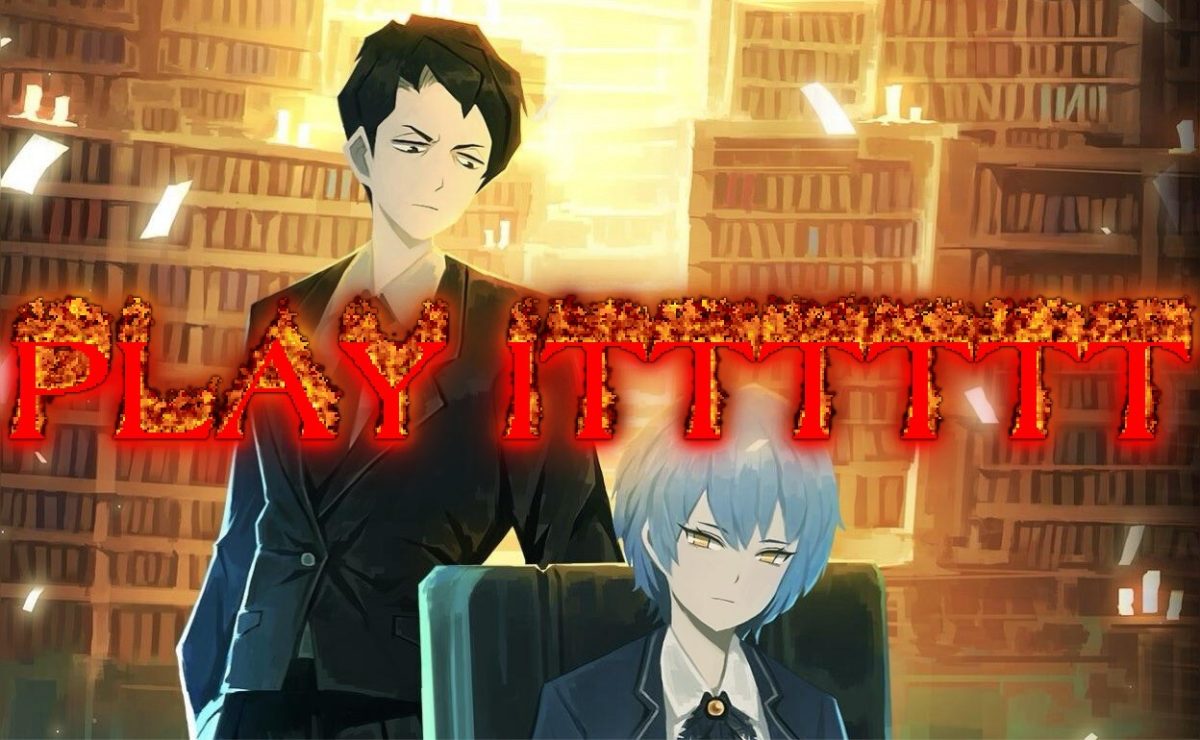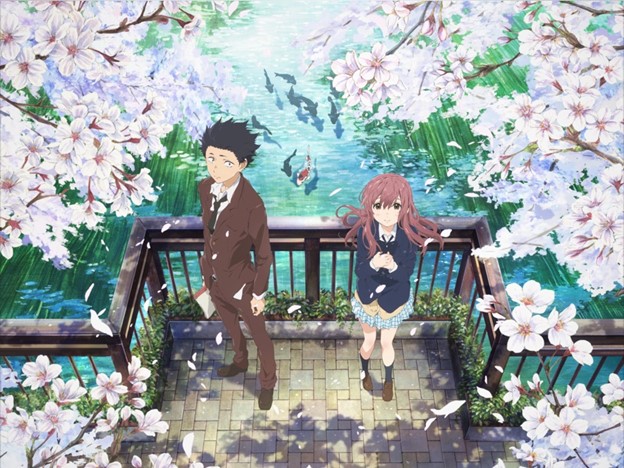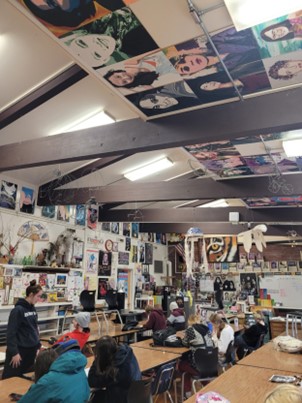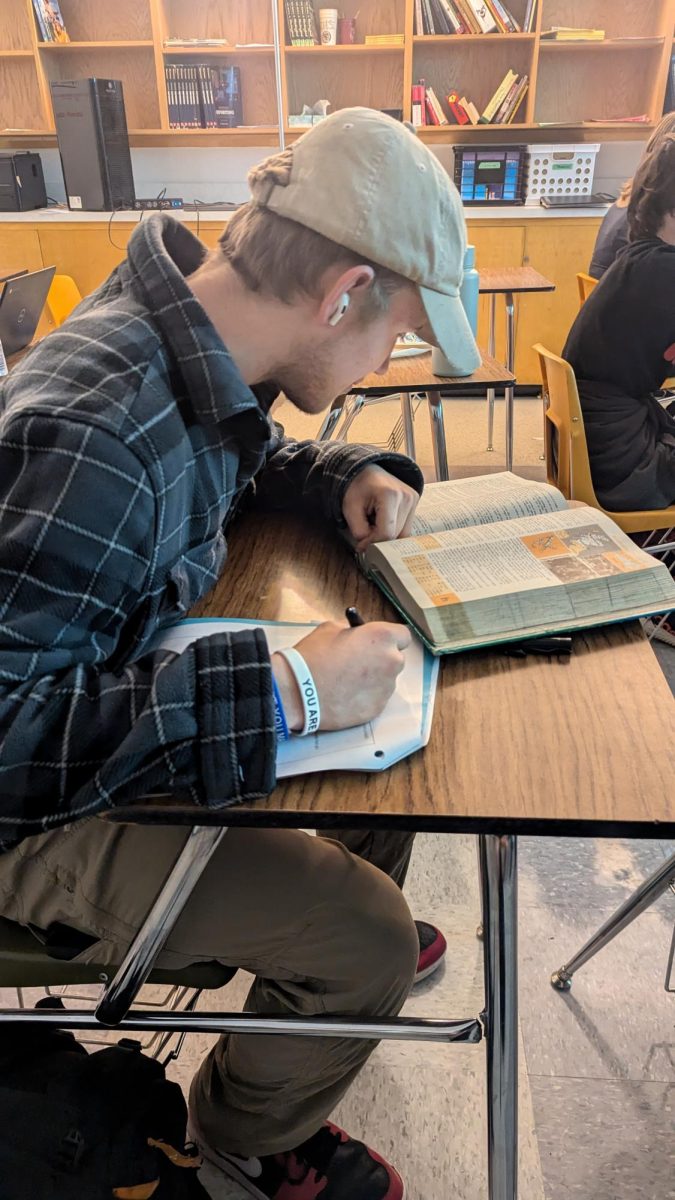I think the title is sufficient.
As of April 25, 2024, Library of Ruina is available for purchase on Nintendo’s portable rectangle and Sony’s decade-old Bloodborne machine. It’s not the first console version of Project Moon’s masterwork, as it also released on the Xbox One back in 2021, but more people getting to play my favorite game ever isn’t something I’m going to complain about.
In case you’re unfamiliar, I’ve already written an article on Library of Ruina for this here publication. It was all the way back in October 2022, during my junior year.
Yeah, that’s right. BEFORE Limbus Company came out. I’m a real fan ELITISM ELITISM SENIORITY SENIORITY



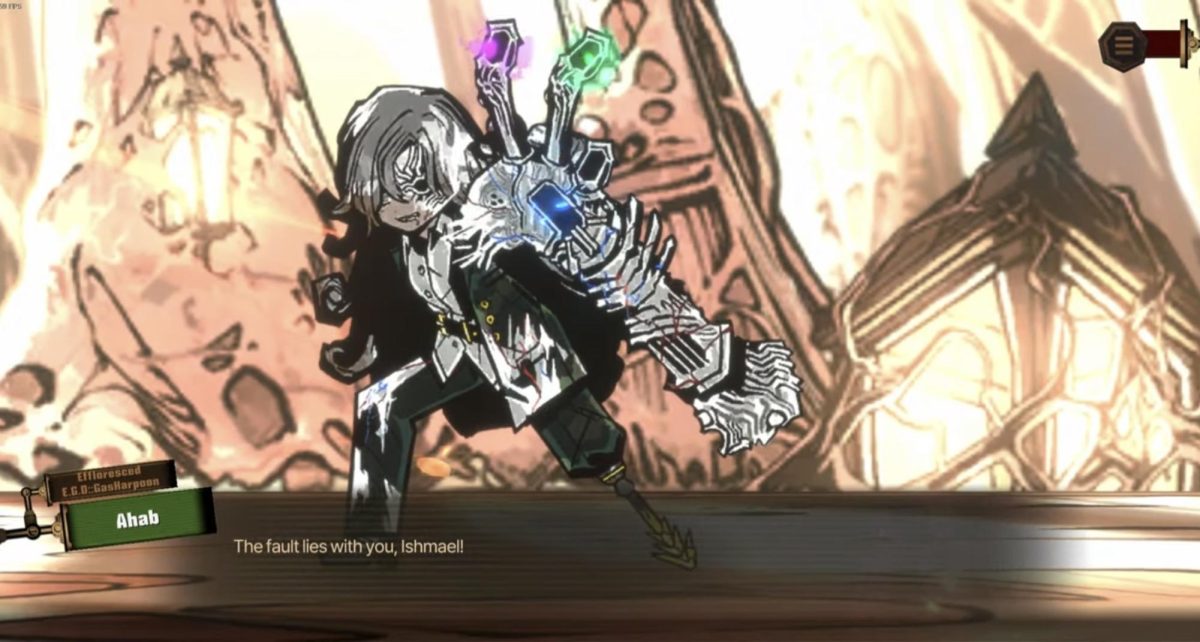
That being said, I do not recommend reading my old Library of Ruina article under ANY CIRCUMSTANCES. Like unless your life is actively on the line, do not even breathe in its direction—it’s SO BAD. I swear, every other sentence was a run-on, I refused to use any full stops; I barely touched on Roland’s arc; I gave only the barest passing mention about the returning Sephirot; and I didn’t even explain how you recover Light during combat. It’s baaaaaaaaad.
Despite my feelings souring on my article about it, my love for Library of Ruina has not waned even slightly. And with this 2024 re-release, it’s relevant again, giving me an excuse to write about it once more!
Taking place in the titular supernatural library, which itself is seated in the dystopian, cyberpunk, hyper-capitalist City, Library of Ruina follows a duo of protagonists: Angela and Roland.

Returning from Project Moon’s previous game, Lobotomy Corporation, Angela is the former head AI of the in-universe Lobotomy Corporation company. In the months since the end of that game, Angela’s spruced up the company’s HQ building, transforming it into the Library, and establishing herself as the director of it. While the renovations are certainly very nice—go off dark academia girlie—there is one big drawback.
Angela and the residents of the Library cannot physically leave it, not until Angela has her hands on the one particular book she seeks. She claims that it will complete her, justify every last second of her suffering at the hands of her feckless creator.
Though the book will be bathed in the blood of many, it will all be worth it if Angela can spite that man from beyond the grave.
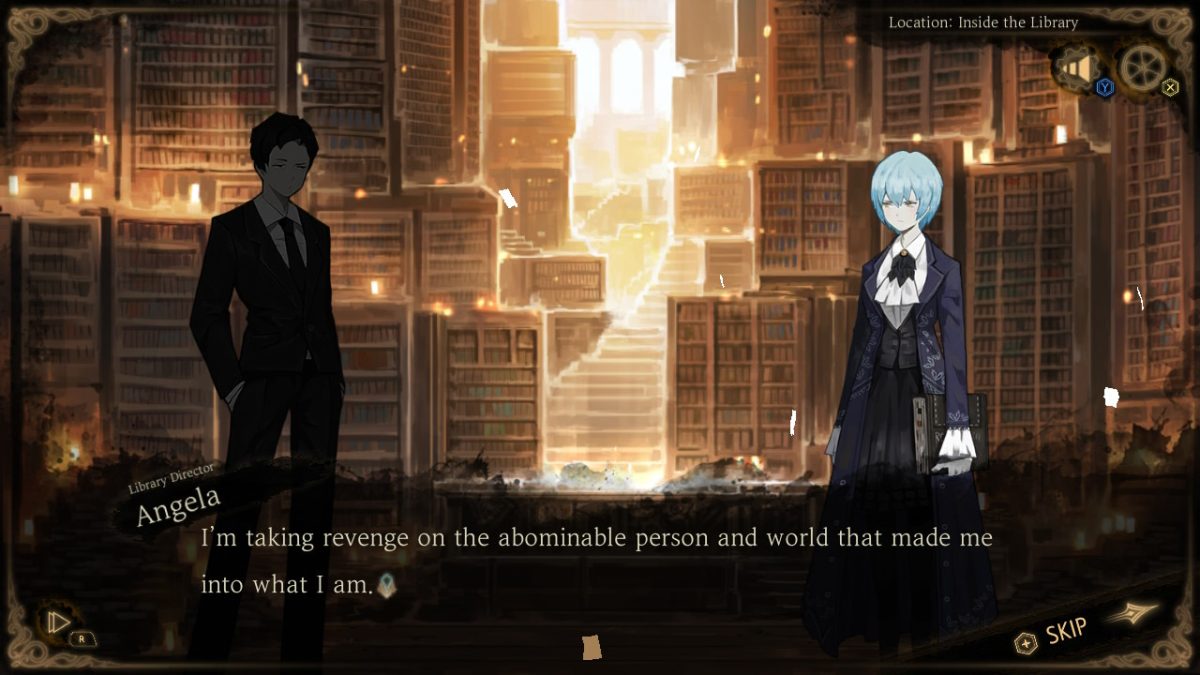
Angela is a girlboss, plain and simple. There’s no other word for it. She’s got a point, she is a legend, she is an icon, and she is the moment. Like, if this is how Swifties feel about Taylor Swift, I get it now. I put so much emphasis on her in my original article for good reason.
Roland, meanwhile, is a down-on-his-luck Grade 9 Fixer. Fixers—ranked from Grade 9 (smelly and bad) to Grade 1 (rather respectable) based on their reputation—do a lot of different things, but our black-suited friend here specializes in information trade. Roland’s rather casual, rather the everyman, but he’s not stupid: he’s incredibly observant and well-traveled, far more than most in the City.
I understand now why I glossed over Roland so much in my initial review: He’s rather . . . malleable as a character. Roland reacts and melds to whatever scene is happening around him, more than he actively instigates. He certainly has opinions and commentary as a seasoned Citydweller, but the man is just mostly along for the ride. And that’s very intentional, showing effortlessly how exhausted he is from living in the City.

Angela and Roland are the heart of Library of Ruina’s story. Their slow-burn character arcs and budding friendship over the course of the ~100-hour campaign is truly beautiful.
Angela is very driven and spiteful, childish and narrow-minded. Roland is jaded and laid-back, but understanding. And crucially, Roland’s a complete newcomer! He’s not involved at all with Lobotomy Corporation and its inner-workings, and therefore, not involved with Angela’s trauma. There’s not that obstacle to overcome in a hypothetical friendship between them.
Roland is someone who Angela can actually become friends with, and she quite enjoys his company. And Roland, after getting comfortable in his new role, comes to enjoy hers as well!
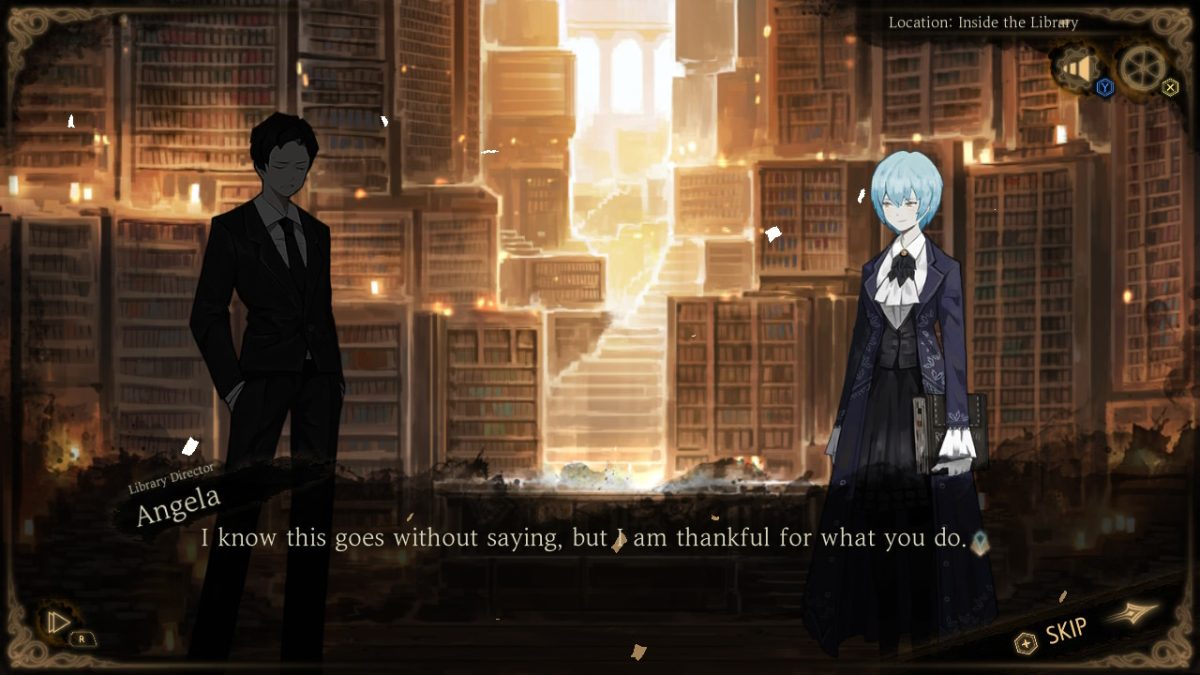
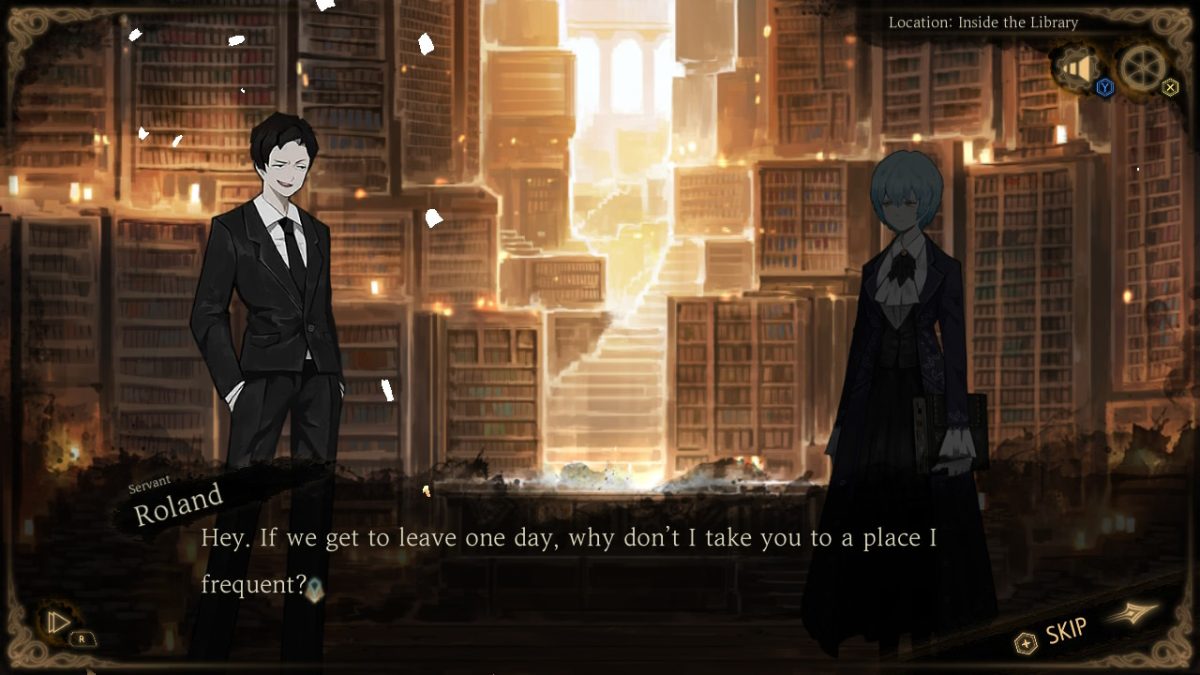
Their friendship is very, very sweet, and to make it even better, it never becomes a romance!
Those two aren’t the only residents of the Library, however. The ten Sephirot from Lobotomy Corporation/Lobotomy Corporation are also here, now librarians at Angela’s beck and call, much the same as Roland. And, with the exception of Binah, they’re all some level of pissed at their coworker-turned-boss.
Here are some testimonials to that fact!
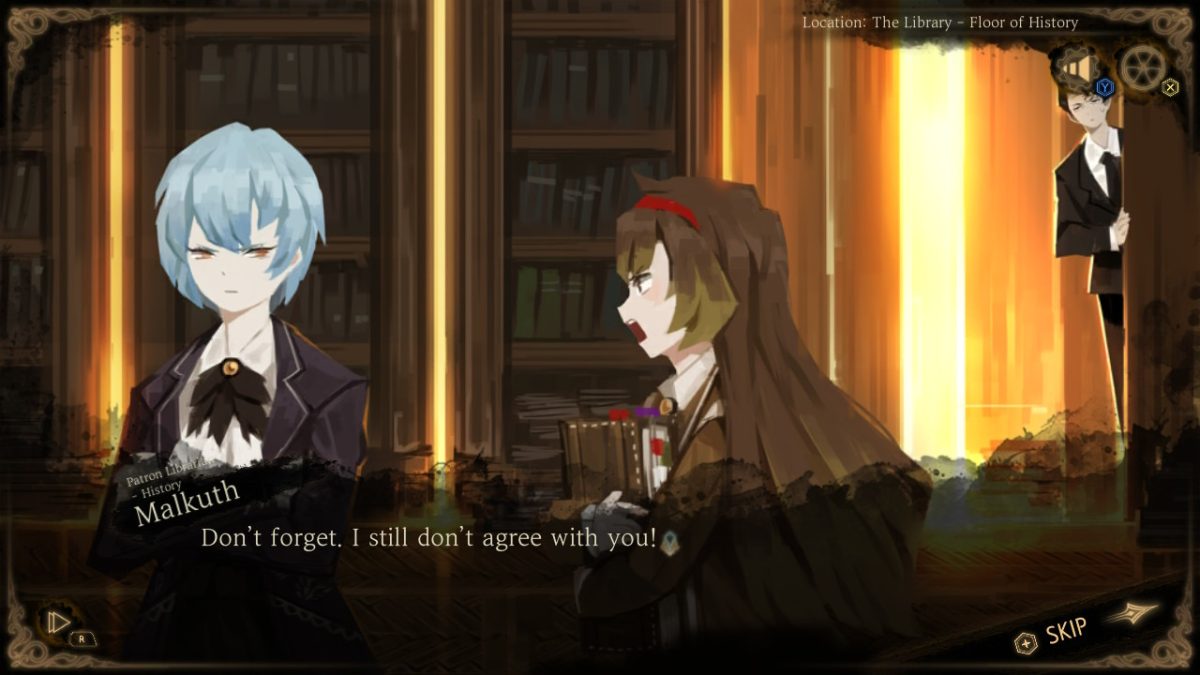
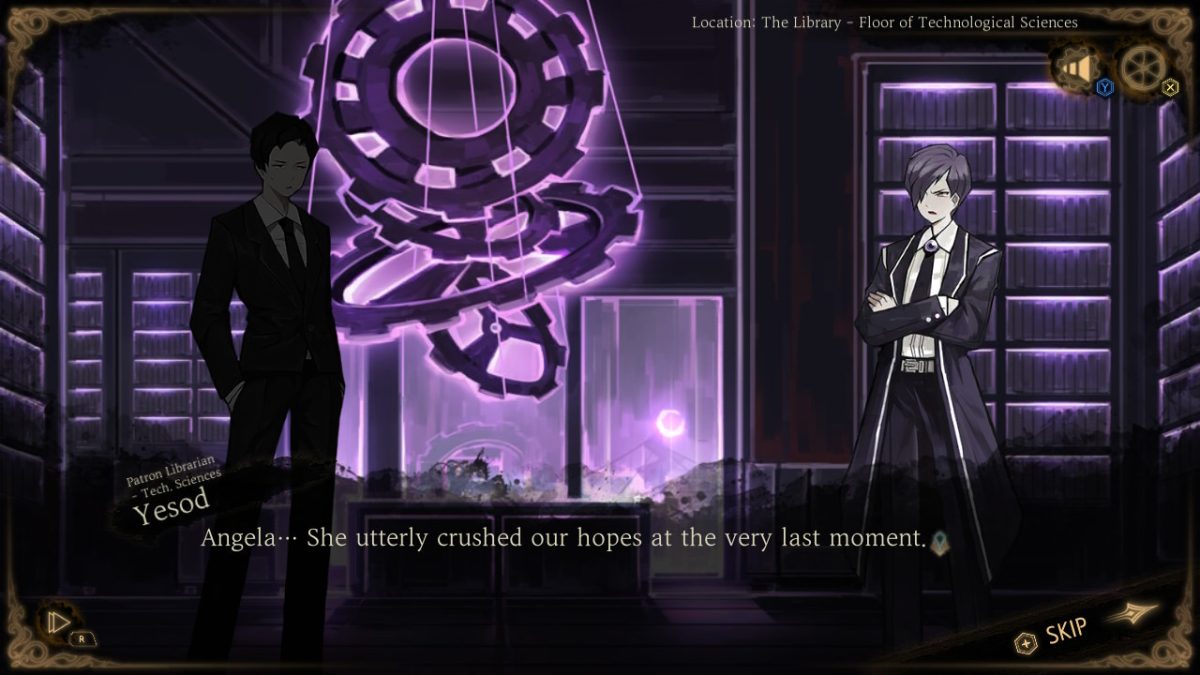
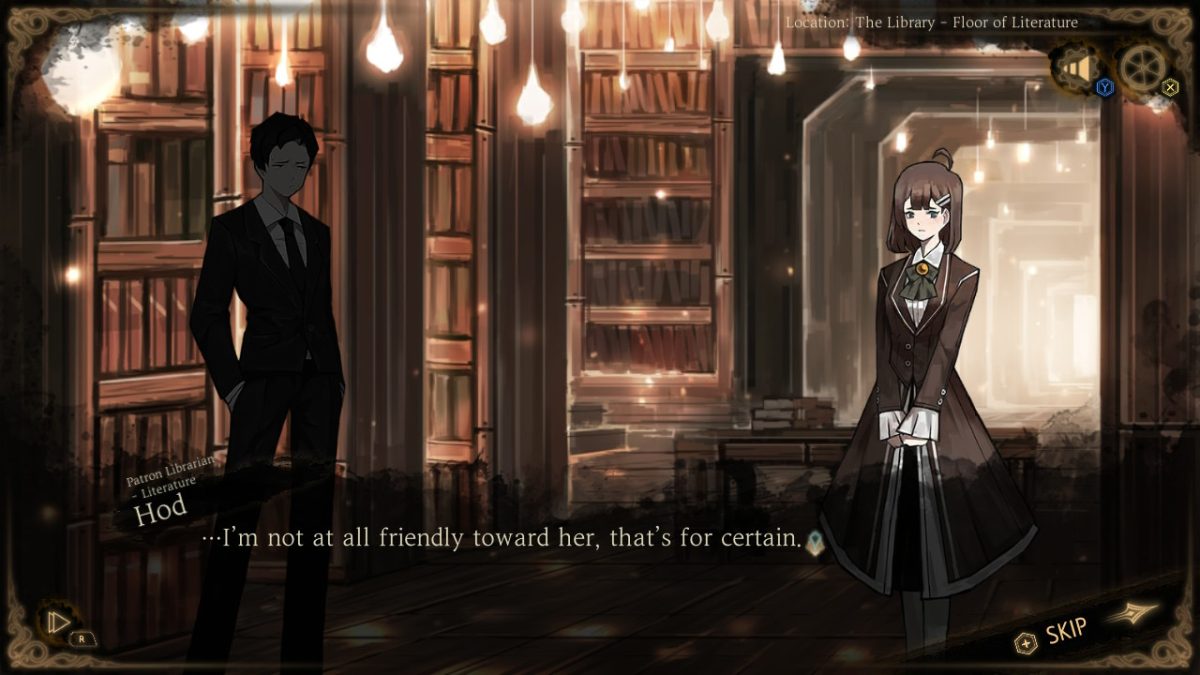
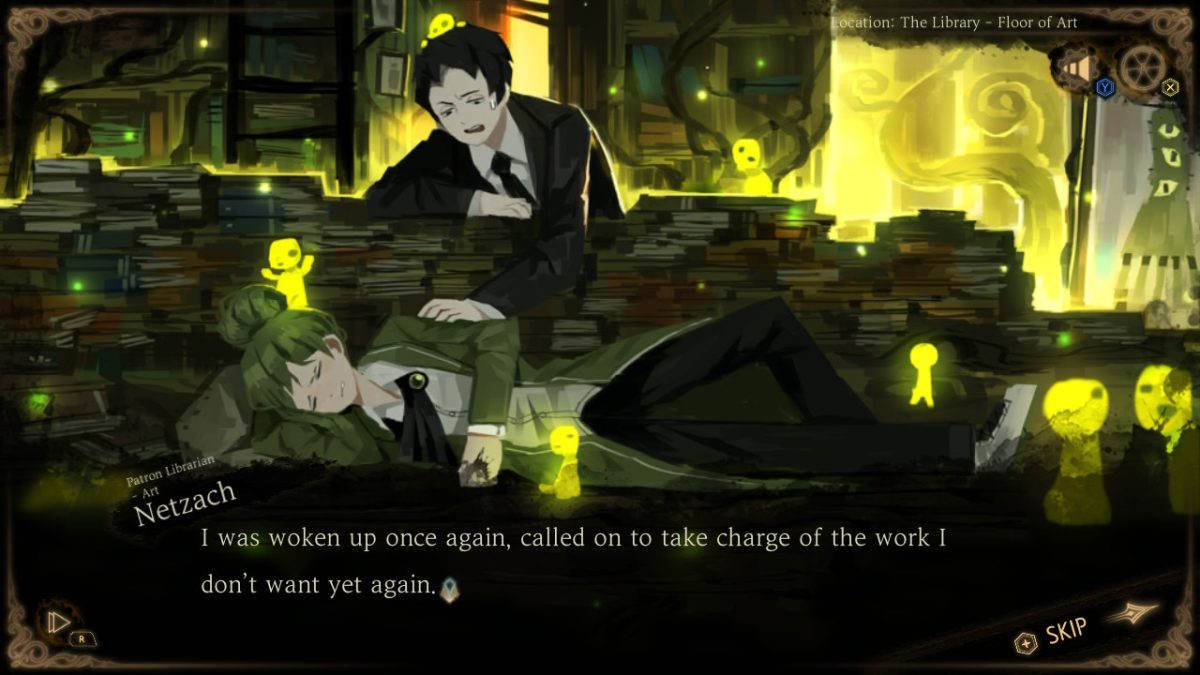
Regardless of their grievances, the Sephirot don’t get a say in the matter. They’re going to help Angela with her library, and that’s final.
But . . . the Sephirot aren’t quite the same people as they were back at the start of Lobotomy Corp. They’ve all undergone their character arcs, and maybe, just maybe, they might be able to get through to Angela.
The question does remain, though: How does Angela, with Roland and the Sephirot aiding her, actually plan to go about enacting her revenge?
It’s quite simple, really.
Murder!
More specifically, murdering people and turning them into books. By using a mysterious invitation, Angela can bring people from all corners of the City to the Library remotely. They all have their reasons for signing the invite, which you get to see in pre-battle story scenes. Some do it out of desperation, some because they’re ordered to by someone above them societally, some to reclaim the books of their loved ones.

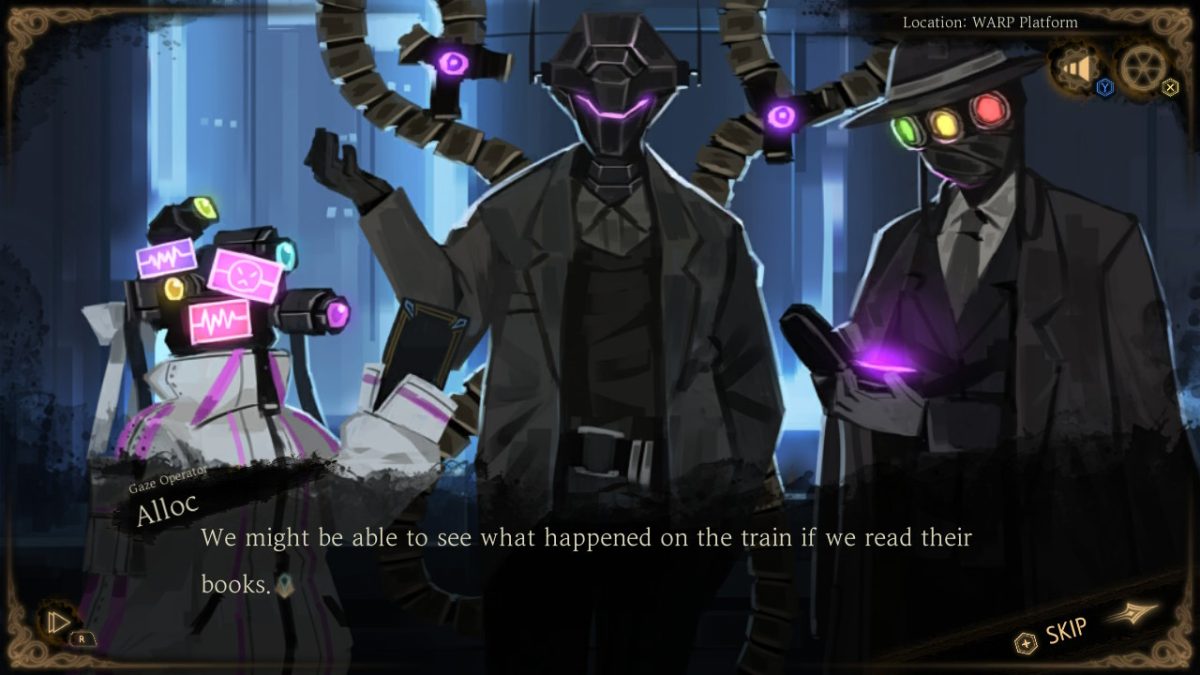


Roland and Angela will also comment on what brings the guests in, letting Roland flex his expositionatory muscles and enlighten the audience about aspects of the world.
After that, the guests will be sent to do battle with your librarians in what Angela dubs a “reception.” If a guest dies within the Library, their life experiences, knowledge, and desires will be instantly condensed to crisp pages and bound in leather, transforming into a book.
From there, Angela can put those books on offer, and the process repeats until the pale librarian gets her hands on the book she’s after. Over and over, more people’s dreams are stolen away from them. Over and over, more and more people lose the ones they love to the Library’s gaping maw.
Over, and over, and over . . .
. . . as a mounting guilt slowly creeps into Angela’s heart.
And it’s in those receptions where the gameplay of Library of Ruina is; it’s a turn-based card game! 😀
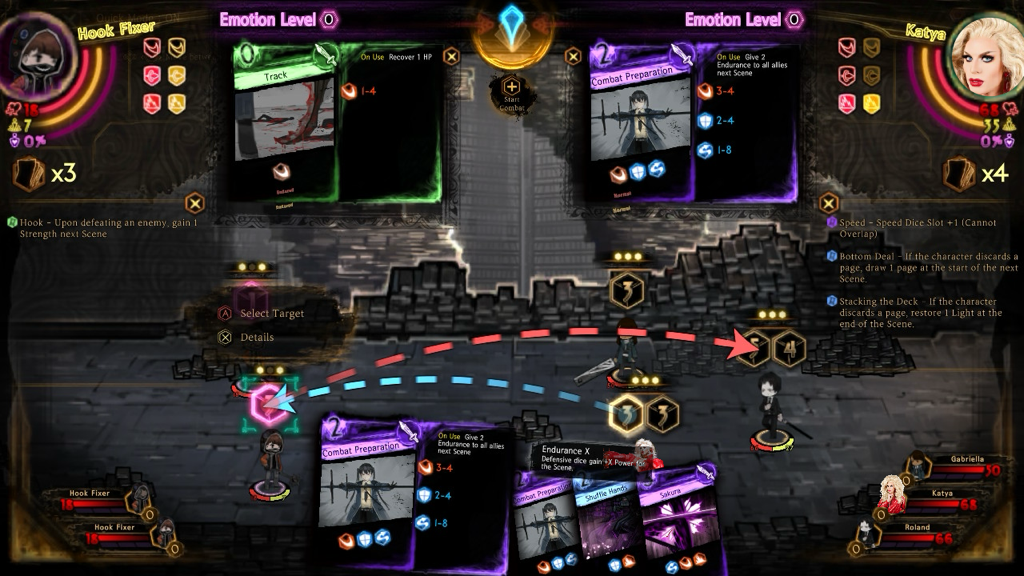
Before the reception starts in earnest, you first choose which floor of the Library will handle the guests. Every floor has different aesthetics and music, but they’re most differentiated from each other by their Abnormality pages. These things add gimmicks to battle that inform how you should build your decks, but that’s several layers (and many hours of gameplay) removed from ground zero.
The simplest place to start with battle is its two phases: the setup phase and the active combat phase.
In the setup phase, you’re tasked with strategizing what cards to use, and whom your librarians will target. Once you’re satisfied with your setup, you can proceed to the active combat phase. Cards will activate their effects, clashes will happen, and combat will occur, until all the cards in play are used. Then, another setup phase will begin; rinse and repeat until every character on one side is eliminated.
Every one of those characters, no matter if they’re a guest, a librarian, or an Abnormality, share specific traits. In addition to the genre-standard, red healthbar, they all have a) Speed Dice, b) a stagger meter, c) a deck of cards, called combat pages, and d) Light.
Other relevant topics included e) equipment, called key pages, and f) team-wide Emotion Level, but those only apply to human enemies, so the Library’s resident horrors will have to sit those out when we get to them.
Starting with Speed Dice, the hexagons that float over every character’s sprite: Rolled at the start of the setup phase, they’re the medium through which combat pages are used. The number a Speed Die rolls determines when a combat page will be used. The higher the number rolled, the earlier the page will be shot off.
In addition, if the target’s Speed Die is (s)lower than your librarian’s, you can force that target into a clash, opening up a WORLD of strategic options.
I know I haven’t explained what a clash is—just bear with me—Library of Ruina’s combat system is really intertwined so you’ll just have to sit in the dark for a bit okay I’m sorry I wish there was a better way but I’ve rewritten this opening section of the combat no less than six times and I’M TIRED
NOW ON TO STAGGER.
Notice that yellow bar adjacent to the healthbar? That’s the character’s stagger meter, and it’s a . . . second healthbar, of sorts. When a character’s stagger meter is depleted, be it through attacking that character or fulfilling a specific condition, they will become staggered. Being staggered not only immobilizes the staggered character for the rest of the current turn and for the entirety of the next one, but it also has them take double damage.
Staggering enemies is one of the most important parts of Library of Ruina’s combat system, so it should be a priority in all fights.
However, enemies can also stagger your librarians, so keep that in mind.

Moving on from stagger, combat pages. They’re the core of Library’s battle system. Every one contains dice, which have a range of numbers they can produce, and those dice are rolled in descending order. To use a page, you need to select a librarian’s speed die, then pick out a page from that librarian’s deck, and finally, choose a target.
If the targeting is one-sided, the page will just go when you start the combat phase. Simples
If the targeting is mutual, though, the combat page users will enter a clash, and the dice on their combat pages will be individually compared. The die that rolls higher wins that round of the clash, then the next dice will go, until all the dice on both pages are used up, and the game moves on to the next clash or one-sided attack.
There are three types of dice that can be on a combat page, which have sub-types within them.
Attack dice are red, and are what they sound like: They attack. They damage. Specifically, they deal HP and stagger damage by the die’s value, factoring in the target’s resistances to the die’s subtype—Slash, Pierce, or Blunt. If the target is Weak or Fatal to Slash, the damage will be greater. Same-same for Pierce and Blunt, and vice-versa if the target is Endured.
Now, defense dice aren’t as uniform. Colored blue, they’re sorted into Block and Evade, and they only work in clashes. If a block die wins a clash, any incoming damage will be deflected, dealing stagger damage.

If a Block die loses a clash, though, any incoming damage will only be reduced, not completely absorbed. Still a good deal!
Evade is more quirky. If an Evade die wins a clash against an attack die, the damage will be negated, just like with a block die. But then, that Evade die will then be reused. It’ll face off against the next opposing die, pushing back the remaining dice on its page. Even just one Evade die can burn, potentially, through all of an opponent’s attack dice, without taking a point of damage!
Also, on clash win, the Evade die heals the evader’s stagger meter by its value! So, on top of potentially not taking any damage at all, Evade dice can also crane-game claw a character right out of stagger range.

Evade dice are stupid and I love them.
But . . . all of that applies only if the Evade die wins the clash. If an evade die loses its clash, then the would-be evader will take the full brunt of the incoming attack. It’s very much an all or nothing situation, whereas Block dice are more reliable.
Defense dice of both kinds also cancel each other out if they clash against each other, so keep that in the back of your brain.
Counter dice are the last kind of die in Library of Ruina. Introduced about halfway through the game, they’re yellow and come in all the different flavors we’ve discussed up until now: Slash, Pierce, Blunt, Block, and Evade. They also have that recycling ability of Evade dice, just now grafted onto attack and Block dice. INSANE
However, Counter dice only activate if the user is one-sided attacked. So, if a character isn’t being faced with an impending smackdown, Counter dice won’t work.
But those’re all generalities. What any individual combat page does lies in the conditionals it and its dice possess. Combat pages can be ranged or attack multiple targets at once, inflict detrimental status effects like Burn, Bleed, or Smoke, decrease the power of an opponent’s dice if they’re in a clash, discard and add exclusive pages to a deck, and so SO much more!
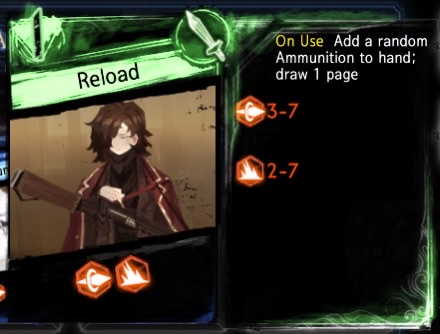
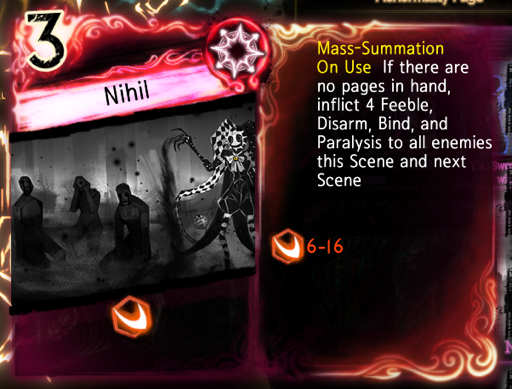
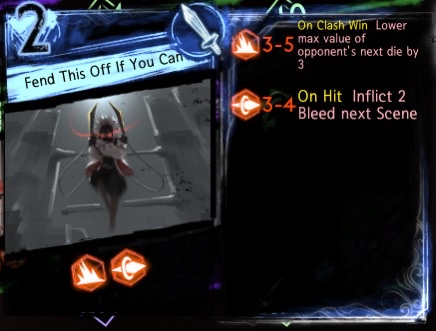
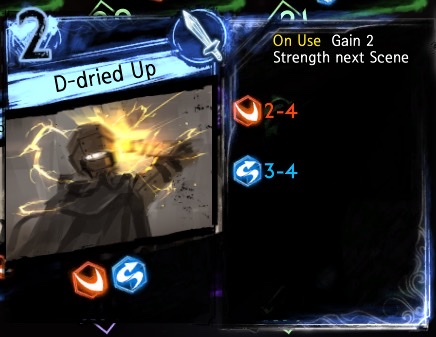
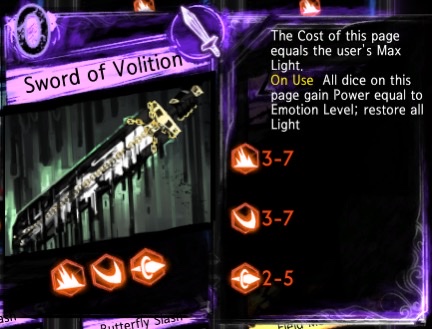

Your librarians’ decks are not infinite, though. They’ll draw one new combat page at the start of every turn, yes, but that’s really not enough. Having some pages that add more to your librarians’ decks on top of that regular flow is straight-up necessary. Shuffle Hands and Relay in particular synergize well in the early game.
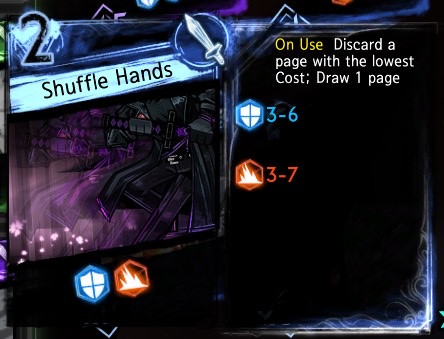

New, fresh combat pages are gained by burning the books of the guests they correspond to. Like Relay and Shuffle Hands, for example. You get those from the books from Jeong’s Office Fixers, who themselves used those pages when they fought you. Now, they’re yours. It’s a really cool system!
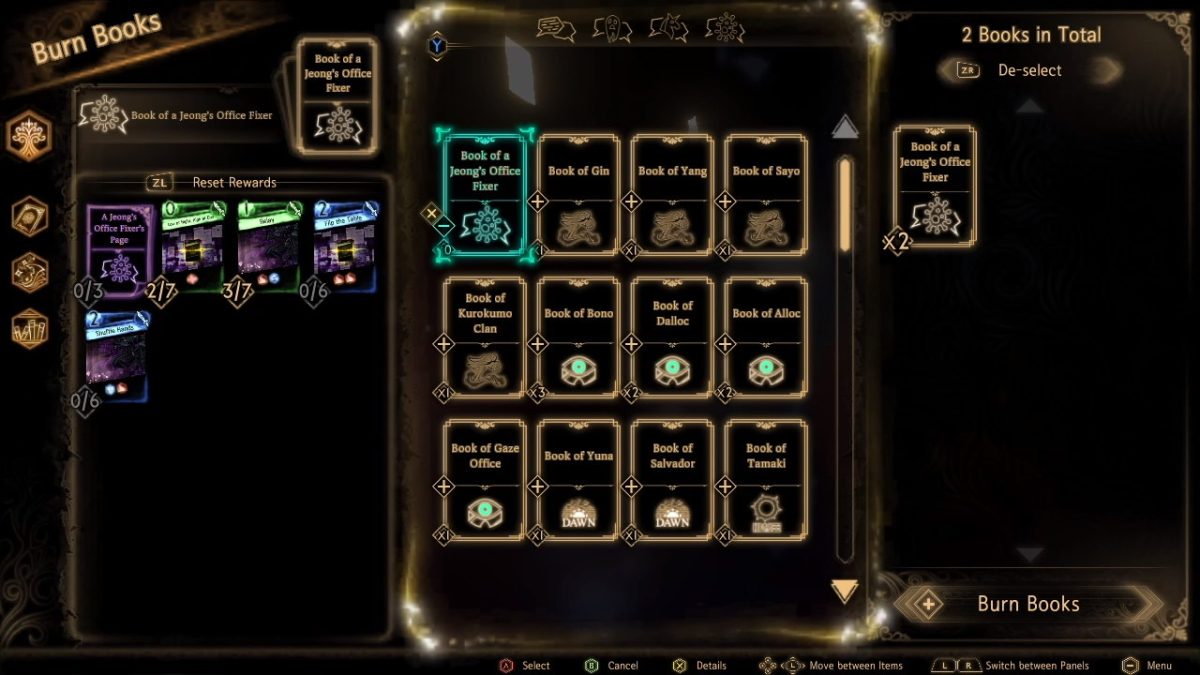
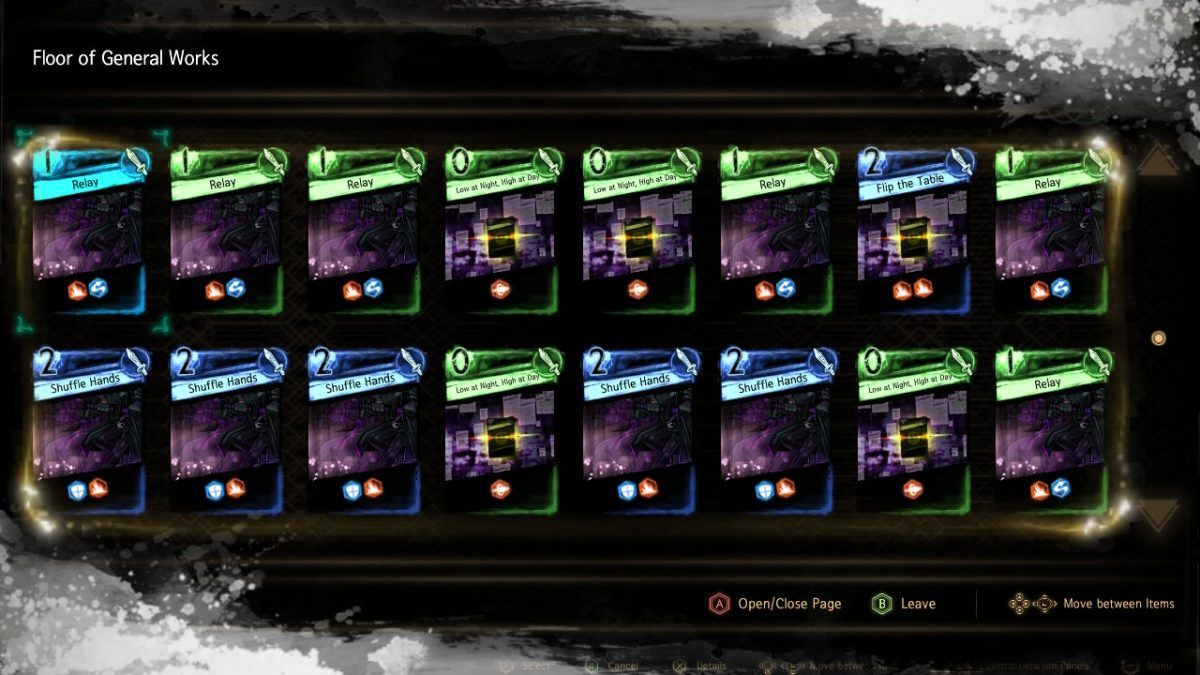
The book-burning is a mini-gacha system, meaning that you’ll need to burn multiple copies of the books—sometimes multiple repeat receptions’ worth—to get everything you want out of them. Having bad luck and having to grind receptions for extra copies can be really, really obnoxious, especially later on.
Those books are also what you use to invite more guests to the Library and progress the story, so . . . ugh.
But to use any combat pages in the first place once you have them, you’ll need Light. The amount a page needs is shown in the page’s upper left corner. Some combat pages cost no Light at all, but a vast majority demand at least a little from you. Every character has their own personal Light bank, shown as the little glowy dots above their sprites.
Like combat pages, your librarians will regenerate one Light every turn.
But, like combat pages, your librarians will only regenerate one Light every turn. That’s just not enough to keep momentum up. Light is also refreshed completely upon a librarian staggering or killing an enemy, but that’s not something you can always do.
This is a PSA: Include some pages that recover Light in all decks you make. For convenience, obviously, but also so that you don’t have to begrudgingly start the combat phase without any pages loaded so that you can use pages next turn. Be kind to yourself.
Back to the book-burning, there’s another kind of page you can gain: key pages. These are the equipment you can outfit your librarians with, changing up not only how they look, but also their Slash/Pierce/Blunt resistances and passive abilities.

Thankfully, once you get a little bit into the game, you can start transferring passives from one key page to another. You’ve got options. There are restrictions, like having a limit on how many pages you can sample from and how every passive has a cost, so you have to decide which passives you want the most. Even with those restrictions, you can still break the game over your kneecaps with careful mixing and matching.
Some key pages also have exclusive combat pages all to themself, like the Sweepers’ Trash Disposal or Nemo’s Energy Beam. Compatibility with those exclusive pages isn’t transferable, though.
The last (not actually, there’s more after this but we are getting close to the end I swear) thing I need to elucidate about Library of Ruina’s battle system is the Emotion Level.
As you clash, you’ll see these little hot pink and green lines jump out of the clashers. You might not notice them at first, with how much stuff is on the screen, but these are Emotion Coins. The winner will be awarded Positive Emotion Coins, the green ones, and the loser will be saddled with Negative Emotion Coins, the hot pink ones.
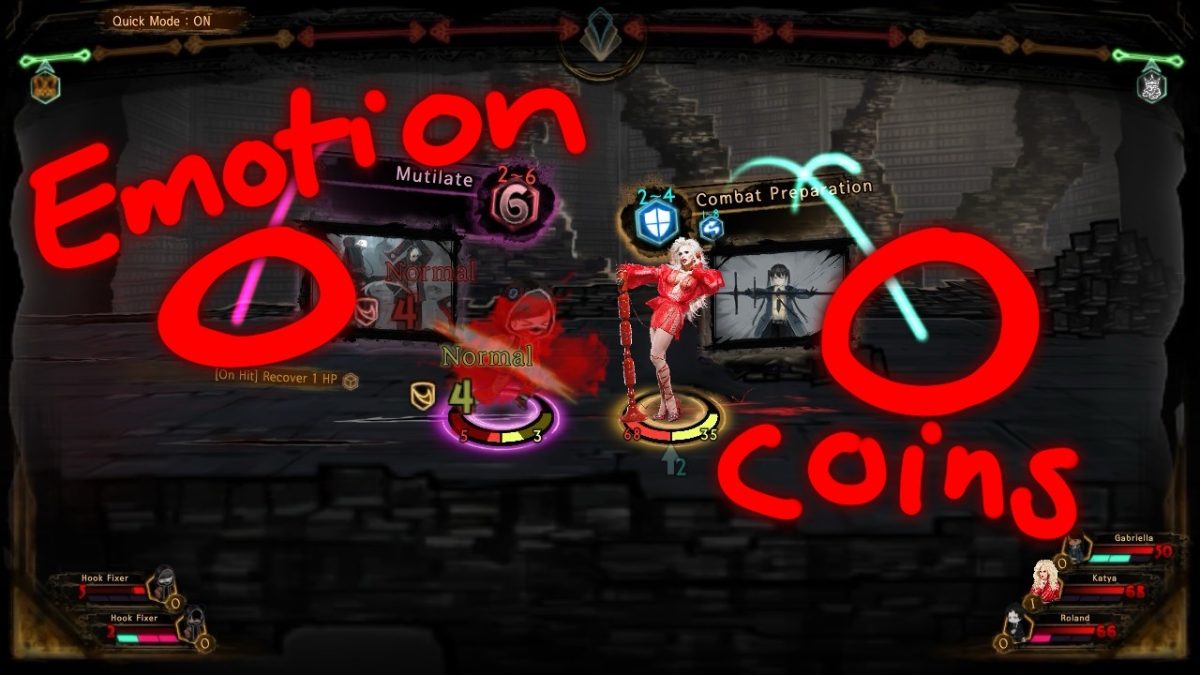
At the end of the active combat phase, every character’s Emotion Coins will be pooled, and their team’s Emotion Level will rise accordingly. Going over the thresholds will increase the max number of Light characters can have, give them more Speed Dice so they can use more pages in one turn, and, in the case of your librarians, grant access to a hand of three Abnormality Pages.
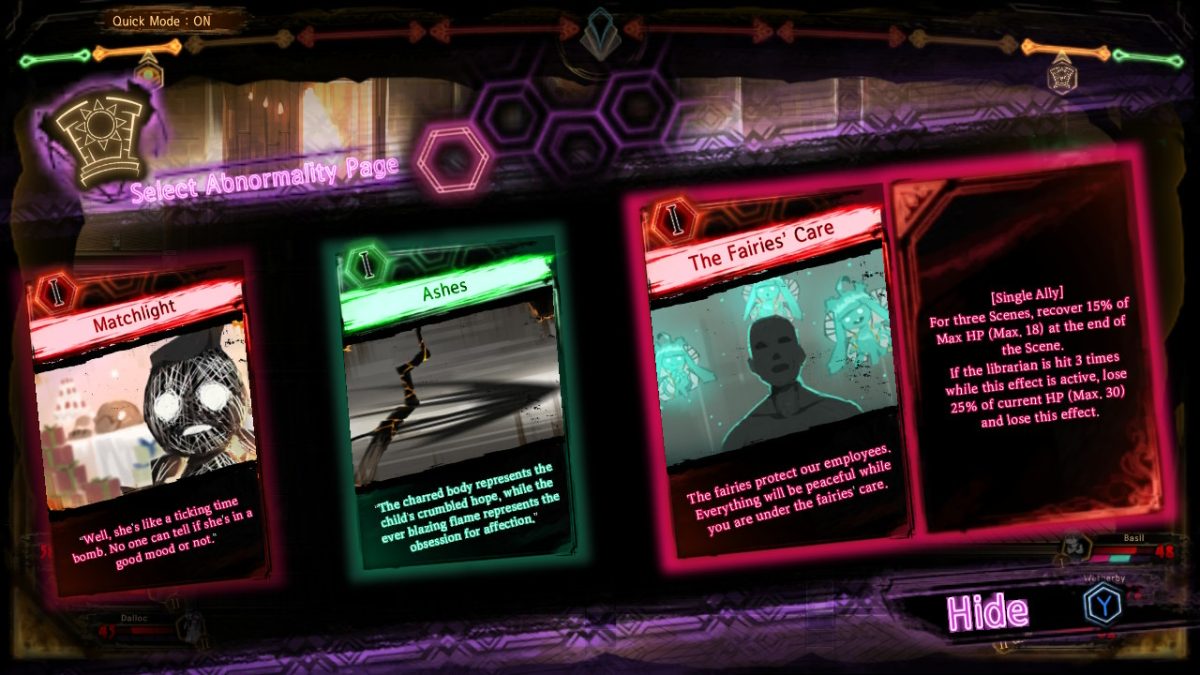
I mentioned Abnormality pages at the start of this segment, but that feels like ages ago, so I’ll restate. Abnormality pages shake up how regular gameplay works, imposing gimmicks that inform how you should build your librarians’ decks. You obtain them by defeating the Abnormalities, back from Lobotomy Corporation.

Once in battle, you’ll be faced with the Abnormality. Unlike guests, Abnormalities don’t have an Emotion Level, and they operate by their own rules. They’re basically big puzzles with a craving for blood, and some of them are a real pain to defeat.
I still hate Judgement Bird. Nay, I revile it to my core.
Fights against these things will open themselves up to you as you meet specific requirements, usually having specific, intact books. If the book gets lost, either by losing a reception or burning it, the Abnormality fight will be off-limits until you get another copy.
You’ll know when you meet the specifications and be notified that a horror is ready to rumble when an exclamation point shows up on one of the floors.
After the horror is defeated, you’ll get to see a scene where Roland interacts with the Sephira of that floor, and from that point on, new Abnormality pages will be available in combat when using that floor.
Some are clear-cut and simple, like Urging. Derived from the Heart of Aspiration on the Floor of General Works, it does this:

But, often, Abnormality pages have way more bite to them. In fact, they’re usually potent double-edged swords, giving as much as they take. For another rather upfront example, Chained Wrath, from the Forsaken Murderer on the Floor of Technology:
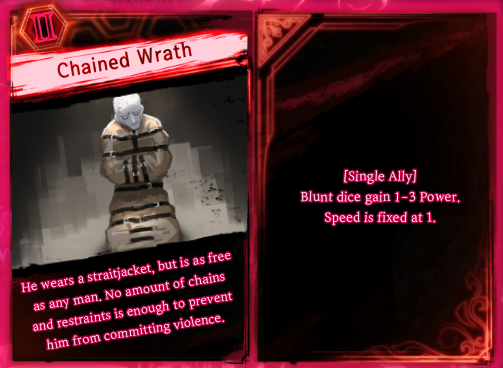
Blunt dice gaining 1-3 power is an insane benefit, even if it does take away your ability to redirect attacks by locking your speed at 1. Whether that tradeoff is worth it is your choice at the end of the day, but Chained Wrath + a deck full of Blunt attack dice will absolutely be beneficial. And that’s not too difficult of a thing to do, even early game.
For one last example, Spring’s Genesis, from Alriune on the Floor of Art:

Also, yes, this image is taken from a screenshot of the PC version, hence the mouse cursor. I couldn’t get to Alriune on my Switch in time for this review sorry 🙁
Not only does Spring’s Genesis add an extra complication by forcing the librarian with this page to target a specific guest, but the universal stagger damage can push a particularly damaged, weary librarian right into the danger zone, if not straight-up staggering them.
But the payoff is crazy. Becoming untargetable for even just one turn allows a lot of free damage, no clashing required, and if you can keep the pace up, a librarian could become invincible literally every other scene.
And to keep that pace up, you need to design around it, even moreso than with Chained Wrath. You have to HAVE TO design your deck around this feature to use it in any capacity. It’s worth it, but it requires commitment.
That’s a pretty good summation of Abnormality pages as a whole. While not all of them are complicated, most are, and they demand full commitment to be worthwhile. If you can’t meet them where they stand, Abnormality pages like Chained Wrath and Spring’s Genesis can be actively harmful or a waste. But if you do what they ask and follow their lead, the results will speak for themselves.
One last thing about Abnormality pages: you might’ve noticed that all of the pages I showed were either green or pink. Urging and Spring’s Genesis are green, and Chained Wrath is pink.
Just like the Emotion Coins. And that’s for a reason.
Every Abnormality page is associated with Positive or Negative Emotion Coins. While the Emotion Level itself doesn’t really differentiate between the two kinds, the hand of Abnormality pages you’re dealt reflects the Positive-Negative ratio. If your librarians are cringefail, losing clash after clash, you’ll probably have only Negative Abnormality pages. If your librarians are serving, slaying their foes effortlessly, however, there’ll be a slew of Positive abnormality pages with your name on it. If you’re just kinda doing okay, it’ll be mixed.
So, if you’re trying to grab a specific page, particularly a Negative page, losing clashes intentionally is actually advised.
Okay, that’s everything.
In summation, Library of Ruina’s battle system is . . . complicated, to put it mildly lol. There are so many moving parts that it left me incredibly confused and overwhelmed when I first played it, and my explanation has probably rendered you a similar way now. It’s a combat system that takes time to learn, but rewards players who put in the effort to understand it.
While the story is no doubt still the main draw and always will be, I’ve come to appreciate the battle system quite a lot more.
Do I recommend Library of Ruina? YES. YES ABSOLUTELY, However, I acknowledge that it is not a game for everyone. As we’ve established, the combat is really overwhelming. But on top of that, a lot of the story is dark and grisly, and there’s a truck ton load of reading.
Shocker, the game about a LIBRARY has a lot of READING.
I’m serious, though. I’m not sure of the exact number, but I wouldn’t be surprised if Library of Ruina’s main story was over 80k words long. And that estimate is not including non-plot text from combat, key, and Abnormality pages, or the guests’ books. Which, yes, you can actually read guests’ books—they’re in the Credenza menu.
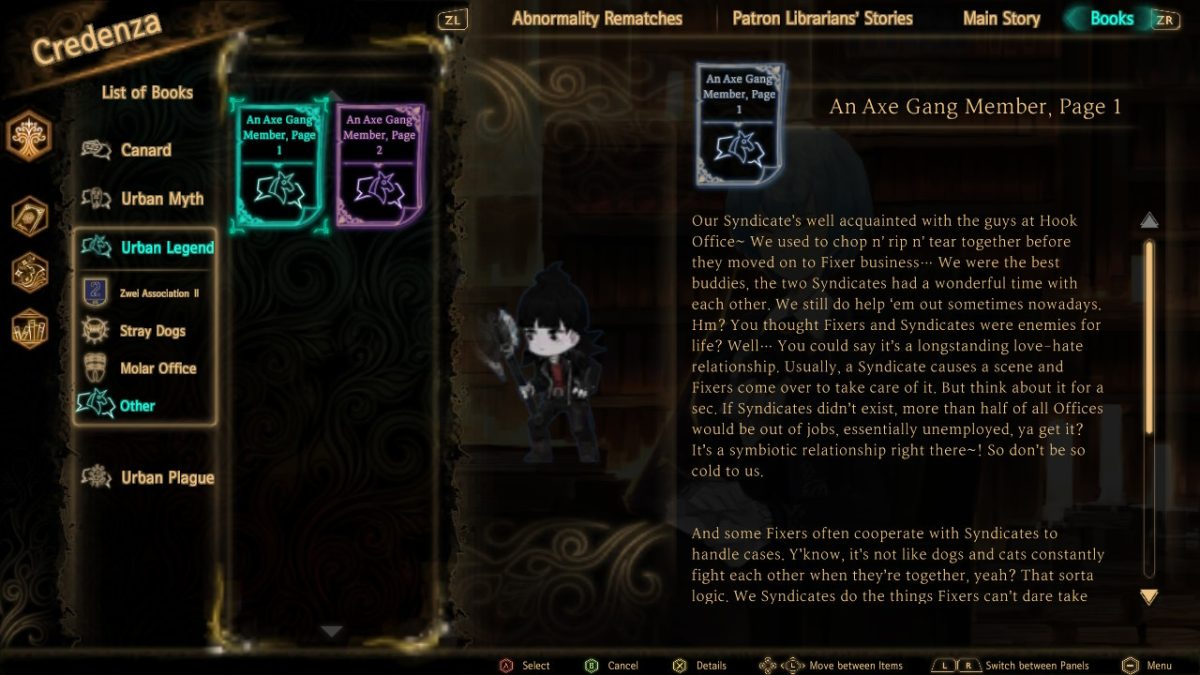
They’re not exactly biographies—they’re a couple paragraphs at most, though there are well over 100 unique guest books to read, so that number does accumulate fast.
And those are OPTIONAL. They aren’t part of the ~80k word main story.
Library of Ruina is literally a novel, and an incredible one. It’s about two people learning that, despite everything, they are safe with each other. That a better way IS possible, if we only reach out our hand. It’s a story about redemption and breaking cycles and unlearning damaging habits in the pursuit of trying to be better, even if we stumble.
It’s a story that I will never forget, and I’m so unbelievably happy that more people will get to experience it.
In fact, one aspect resonated with me way more than it did the first time I played Library. Angela’s blind obsession with the one book, placing all of her eggs in that basket—I’ve done that. Recently, too. If you know, you know.
And that makes me love Angela and her arc even more than I did before. I didn’t even think that was possible!
Library of Ruina really is a gift that keeps on giving.
But, and I feel bad about undercutting that positive note, this article is specifically about the Nintendo switch/PS4 port or Library of Ruina, which . . . has some issues.
To navigate the menus, you need to use both shoulder buttons and your sticks/d-pad, which just feels bad. Combat is fine, but menuing is not ideal. Idk how else Project Moon and Arc System Works could’ve translated the mouse controls to systems that don’t have mouse capabilities, but it’s painfully clear that this is not the control scheme the game was originally designed around.
Furthermore, some assets aren’t upscaled properly? Like, some cgs are pretty blurry, and you have to really squint to see characters’ subtitles. Like, go back to the image of the Malkuth arguing at Angela and you’ll notice it.
Also, you can’t customize your librarians’ names and in-battle dialogues. In both cases, all you get to choose from are presets. It’s weird. That’s why Katya Drag Race and Daphne Scooby-Doo are my librarians in a couple of the images, instead of, say, the Kool-Aid Man or the Freddy Fazbear: their first names are among the list of presets. They’re the only options if you don’t want just generics.
When it comes to how these console versions compare to vanilla PC Library of Ruina, that’s where the complaints end.
But there’s one elephant still in the room, and it looms large.
Library of Ruina on PC has mod support. Infinite new receptions, including the incredible Librarian of Death mod, custom key pages like Yoomtah Zing from Epithet Erased, and quality of life improvements aplenty. If you have the option, I’d definitely advise going with the PC version.
Regeardless of all the little problems this port has, if it’s your only option, I’d still say go for it. Library of Ruina is a game that everyone should experience, even this sorta scuffed version. It altered the trajectory of my life—I admit that—and it did so for the better. It’s worth it’s time in gold, warts and all.
Go (to the Library) Bengals!


